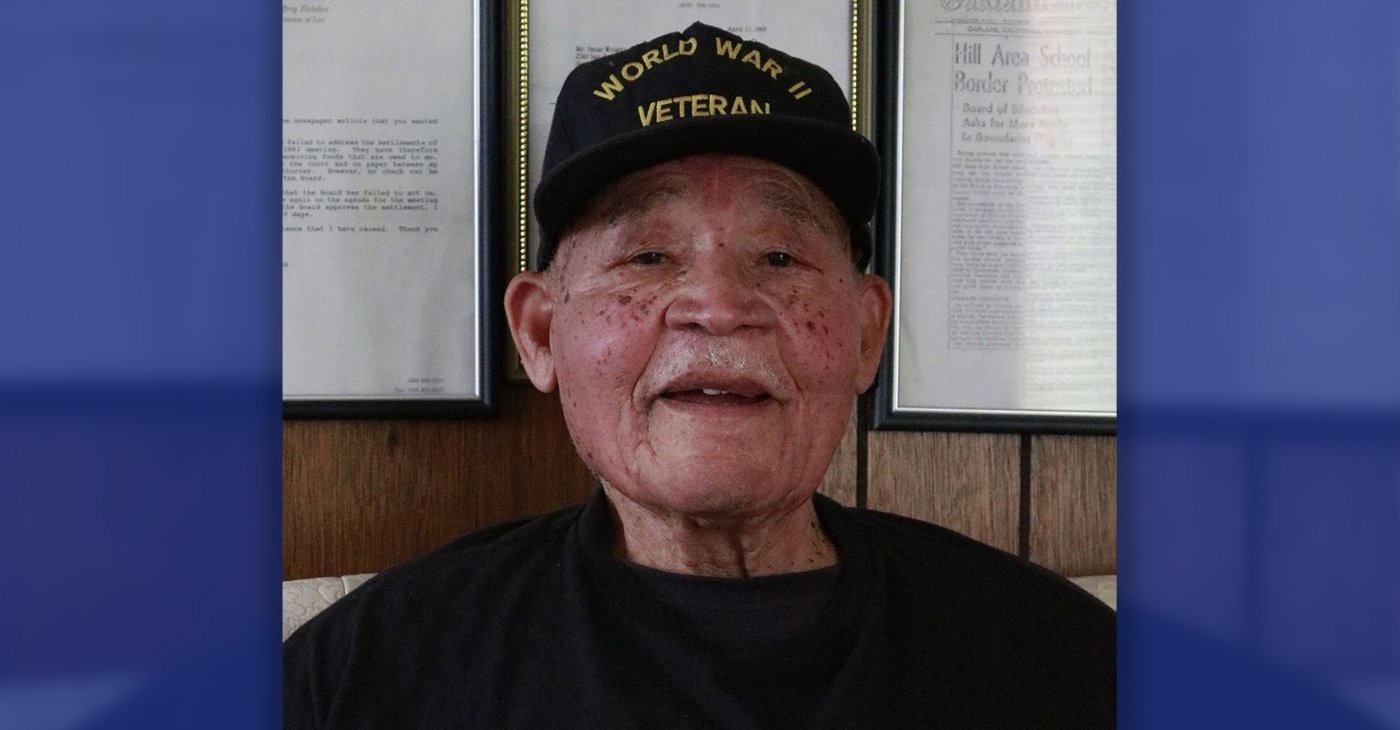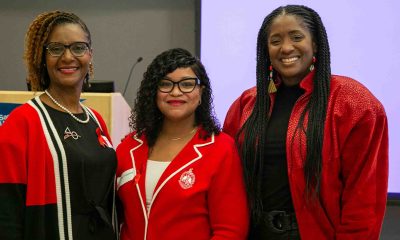Black History
Opera and the African American – ‘Figaro Meets Frederick Douglass’
NNPA NEWSWIRE — “Our artistry is vast, and can be used in many ways, but without funding for creating new stories with casting of old stories in collaboration with advertising and marketing, one might think Black people never existed or have a place to shine in opera, which causes another challenge.”
By Stacy M. Brown, NNPA Newswire Correspondent
@StacyBrownMedia
Among many other trailblazing accomplishments, W.E.B. Du Bois stood among the many African Americans who composed, sang, and otherwise reveled in opera.
In 1955, Marian Anderson broke the color barrier at the Met. Yes, Blacks in opera – it’s a thing.
Opera is as much a part of the African American as Rhythm & Blues. It just hasn’t always been as celebrated, according to historians.
Consider, 19th century black singers like Elizabeth Taylor Greenfield and Sissieretta Jones sang opera but reportedly gave recitals because the opera houses refused to hire them.
Black churches were performing Verdi’s Requiem with all-Black casts and musicians. Coretta Scott King attended the New England Conservatory, planning to be an opera singer, according to Hyperallergic, a web forum for serious, playful and radical thinking about art.
Officials at the Coalition for African Americans in the Performing Arts – or CAAPA – said they’re dedicated to “Bringing Color to the Classics.” The organization advocates for diversity on the stage on behalf of Black classical musicians, youth and others in the performing arts.
Through the nonprofit organization’s newly formed International Outreach Program, CAAPA provides a vibrant musical experience, bringing culturally diverse performance opportunities to the community and underserved population while promoting Black classical musicians and others in the performing arts.
The International Outreach Program offers concerts, recitals, festivals, panels, workshops, exchanges, musical performances, and more. The program will also target diverse populations in elementary, middle and high schools, camps, youth programs, as well as adult audiences, including seniors.
Officials hope the program will help overcome the radical racial barriers that have long kept Blacks out of the opera. “Like any other professional field or industry, there is always racial bias. However, it has gotten moderately better in past years,” said Terri Allen, the executive director of CAAPA.
For instance, Allen said when CAAPA began in 2003, only 3 percent of all opera companies and symphony orchestras had main stage roles for Black musicians.
Today, that total has risen by almost 5 percent – much of it can be attributed to the work that CAAPA has done on behalf of Black classical musicians. “While overall, it has gotten better, these challenges allow us to continue creating spaces for ourselves to tell our stories, as well as other stories that may not always look like us, while adding our perspective and artistry along the side of our colleagues who are not Black,” Allen said.
CAAPA is very aggressive in this regard.
“We deliberately create performance opportunities for Blacks. For instance, this season’s performance roster includes programs such as, ‘Figaro Meets Frederick Douglass’; ‘Musical Tribute to Shirley Chisholm’; and ‘Cotton Field to Concert Hall,’” Allen said.
Among the continued challenges is recognition of the seemingly endless pool of Black talent.
“CAAPA would love to have Black artists be seen and provided with an opportunity to shine purely based on skill and talent with consideration for casting and being matched alongside any other artist regardless of skin color, height, or weight,” Allen said.
“Often times, it is not what you know, it is who you know, when chosen for an opera. In some cases, plots in opera require a distinct ethnicity of a character to help further tell the story and assist with visually displaying the obstacle, while other operas can be more daring in casting.”
Allen continued:
“One opera even [literally] states the ethnicity of its characters. Representation is important and educates many who believe that opera is not a place for a Black person while exposing the existence of Black people already in opera.
“Our artistry is vast, and can be used in many ways, but without funding for creating new stories with casting of old stories in collaboration with advertising and marketing, one might think Black people never existed or have a place to shine in opera, which causes another challenge.”
Another challenge remains funding, Allen added.
“Statistics show minority organizations generally receive less and lower amounts for grants, resulting in fewer program including Black musicians,” she said.
Still, the outlook remains positive for Blacks in opera.
In its “Bringing Color to the Classics” efforts, CAAPA’s mission is to make opera more acceptable and palatable to the Black community through various programs, Allen said.
“Opera is a vessel that isn’t used often to tell a story like other vessels including Musical Theater, Stage Play, and Movies,” she said. “At times it can be challenging for Black opera singers to stay in an art form that some folks don’t see as valuable – African Americans traditionally tend to gravitate toward R&B, Jazz, Pop, Blues, Hip Hop, and Gospel – thus disregarding Opera as a legitimate art form for the Black community.
“CAAPA strives to change that attitude. CAAPA believes the outlook is good and moving forward.”
To find out more CAAPA and its programs, visit www.4caapa.org
Activism
Oakland Post: Week of December 25 – 31, 2024
The printed Weekly Edition of the Oakland Post: Week of December 25 – 31, 2024

To enlarge your view of this issue, use the slider, magnifying glass icon or full page icon in the lower right corner of the browser window. ![]()
Activism
Living His Legacy: The Late Oscar Wright’s “Village” Vows to Inherit Activist’s Commitment to Education
Kingmakers of Oakland (KOO), a nonprofit organization that works to improve educational and life outcomes for Black boys and men, stated that “Oscar Wright is one of the most prolific, consistent, and committed advocates of equity for Black students and Black Families here in Oakland for the past six decades.”

By Antonio Ray Harvey, California Black Media
Activists mourning Oscar Carl Wright’s death, have pledged to continue his lifelong mission of advocating for Black students and families in Northern California.
Wright, 101, who passed away on Nov. 18, was involved in Oakland’s educational affairs until his death.
Now, friends and admirers acknowledge that carrying on his legacy means doubling down on the unfinished work that Wright dedicated his life, time, and resources to, according to Y’Anad Burrell, a family friend and founder of San Francisco-based Glass House Communications (GHC).
“Mr. Wright did a lot of work around equity, specifically, for Black students based on their needs — whether it was tutoring, passing classes, or graduating,” Burrell said.
Wright became a champion for his children’s education, recognizing the disparities between their school experiences and his own upbringing in the Mississippi Delta.
Burrell told California Black Media (CBM) that the crisis of unequal access to resources and a quality education continues to affect the Oakland Unified School District (OUSD).
According to Oakland Reach, in the city of Oakland, only 3 in 10 Black and Brown students are reading at or above grade level. In addition, only 1 in 10 are doing math at or above grade level.
Oakland REACH is a parent-run, parent-led organization. It aims to empowers families from the most underserved communities to demand high-quality schools for their children.
Wright’s work as an activist had impact across the state but he was primarily known in the Bay Area. Alongside the Black United Front for Educational Reform (BUFER), he filed a complaint against OUSD for violating the Civil Rights Act of 1964.
In 2000, the OUSD school board proposed an action plan to address educational inequity, but it was never implemented.
Wright later founded the African American Honor Roll Celebration at Acts Full Gospel Church, an award that recognizes Black students with a grade point average of 3.0 or better. Each year, more than 1,000 students are honored at this ceremony.
Kingmakers of Oakland (KOO), a nonprofit organization that works to improve educational and life outcomes for Black boys and men, stated that “Oscar Wright is one of the most prolific, consistent, and committed advocates of equity for Black students and Black Families here in Oakland for the past six decades.”
Burrell said that one of the main reasons Wright’s work was so essential for families and children in Oakland that is the direct relationship between acquiring a quality education and affording quality housing, maintaining food security, achieving mental wellness, and securing stable employment.
Wright was the child of sharecroppers from Coahoma County, Mississippi. He attended Alcorn State University, a Historically Black College and University (HBCU).
In the late 1950s, Wright and his family relocated to the Bay Area where he worked as a contractor and civil engineer. He later became an active member of the National Association for the Advancement of Colored People (NAACP).
Burrell said the people who will carry on Wright’s work are part of a “village” that includes KOO’s CEO Chris Chatmon. Wright was a mentor to Chatmon.
“It will not be one entity, one person, or one organization that picks up the baton because it was a village effort that worked alongside Mr. Wright for all these years,” Burrell said.
Burell says that legacy will live on.
Activism
Celebrating East Bay Leaders Keith Carson and Federal Glover at Geoffrey’s Inner Circle
Several leaders were in attendance including fellow Alameda Supervisors Elisa Marquez and Lena Tam, Superior Court judge-elect Terry Wiley, and African American Sports and Entertainment Group’s founder Ray Bobbitt, along with many other guests.

By Magaly Muñoz
After decades of public service in the East Bay, community members and leaders came together to celebrate Alameda County Supervisor Keith Carson and Contra Costa Supervisor Federal Glover at Geoffrey’s Inner Circle Thursday afternoon.
Several leaders were in attendance including fellow Alameda Supervisors Elisa Marquez and Lena Tam, Superior Court judge-elect Terry Wiley, and African American Sports and Entertainment Group’s founder Ray Bobbitt, along with many other guests.
First elected in 1992, Carson has served District 5 for 24 years and announced his decision to step away from his seat earlier this year, just before the deadline to submit new candidate applications.
He dedicated his long career to bringing access to health care, addressing homelessness, lowering crime, improving business retention, and growing job opportunities in Alameda County.
Glover began his tenure as Contra Costa Supervisor in 2000 and previously served as mayor of Pittsburg in 1998. During his time as Supervisor, he supported initiatives on public transportation, created committees for public safety, and supported task forces on health.
“These two distinguished leaders have dedicated their lives to improving the lives of so many people across Alameda and Contra Costa (counties). Their work has touched every corner of the East Bay,” Alameda County Supervisor and President Nate Miley said.
Leaders from both counties spoke on the supervisors’ legacies and their dedicated years of service.
Contra Costa Supervisor John Gioia said that Glover was the type of person that grew with each challenge that crossed him, especially after he had major surgery in 2020. But Gioia said that the treatment did not deter Glover.
“He’s had tougher races for reelection than any member of our board that I can recall, and he’s always come back stronger than before,” Gioia said.
Sharing a county border, Gioia complimented Carson on his ability to sway leaders from both sides of the political aisle to listen on the issues affecting locals and residents across the nation.
Shannell Scales Preston, who is taking over Glover’s D5 seat in 2025, told event attendees that Glover was a mentor to her for many years. He often would call Preston after Pittsburg City Council meetings with remarks about her performance and how well she spoke up on certain issues.
With Glover spending years as the only Black elected official in local government, Preston would ask him how he managed to not feel lonely about the job. She then congratulated him on being the only supervisor in Contra Costa to have all Black mayors under his district in 2023.
Preston said he’s been a leader to many diverse groups and his tenure has seen leaders of all backgrounds, but particularly paving the way for Black leaders in predominantly white areas.
Miley, who has shared his entire 24-year tenure on the Alameda Board with Carson, tearfully wished the exiting supervisor luck and said he would miss him dearly.
Carson said that as we embark on a “dark time” for everyone across the nation and worldwide in 2025, it’s important to continue communicating and working with groups from all backgrounds because that is the only way things will get done.
“There have been many lonely nights, but then the sun comes out in the morning when you continue to think, ‘I can make a difference,’” Carson said.
-

 Activism4 weeks ago
Activism4 weeks agoOakland Post: Week of November 27 – December 3, 2024
-

 Activism2 weeks ago
Activism2 weeks agoButler, Lee Celebrate Passage of Bill to Honor Congresswoman Shirley Chisholm with Congressional Gold Medal
-

 Activism2 weeks ago
Activism2 weeks agoPost News Group to Host Second Town Hall on Racism, Hate Crimes
-

 Activism2 weeks ago
Activism2 weeks agoDelta Sigma Theta Alumnae Chapters Host World AIDS Day Event
-

 Business2 weeks ago
Business2 weeks agoLandlords Are Using AI to Raise Rents — And California Cities Are Leading the Pushback
-

 Activism3 weeks ago
Activism3 weeks agoOakland Post: Week of December 4 – 10, 2024
-

 #NNPA BlackPress4 weeks ago
#NNPA BlackPress4 weeks agoNational Action Network Announces 2025 Inauguration Day Rally
-

 Arts and Culture1 week ago
Arts and Culture1 week agoPromise Marks Performs Songs of Etta James in One-Woman Show, “A Sunday Kind of Love” at the Black Repertory Theater in Berkeley




























































